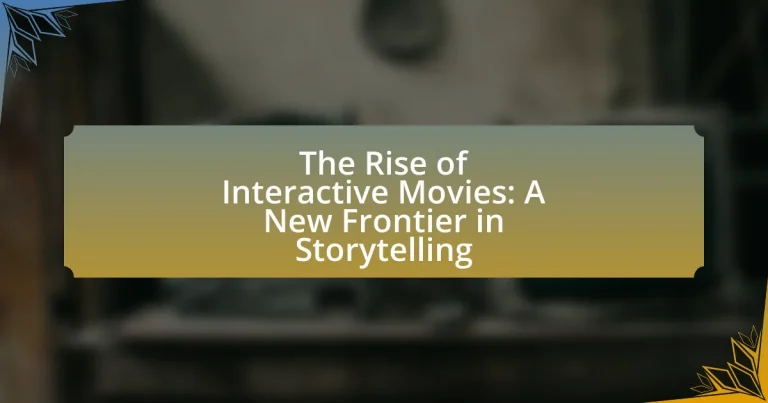Interactive movies represent a new genre of film that allows viewers to influence the narrative through their choices, creating a personalized viewing experience. This article explores the defining features of interactive movies, including user agency, branching narratives, and real-time feedback, which differentiate them from traditional films. It examines the technological advancements that have facilitated their rise, such as streaming platforms and interactive storytelling software, and discusses the impact of audience preferences on their popularity. Additionally, the article addresses the challenges faced in production and user experience design, while highlighting future trends and best practices for creators in this evolving medium.

What are Interactive Movies?
Interactive movies are a genre of film that allows viewers to influence the narrative through their choices, creating a personalized viewing experience. This format combines traditional storytelling with interactive elements, enabling audiences to make decisions that affect character outcomes and plot developments. Notable examples include “Bandersnatch,” part of the “Black Mirror” series, which offers multiple endings based on viewer choices, demonstrating the potential of interactive storytelling in engaging audiences in new ways.
How do Interactive Movies differ from traditional films?
Interactive movies differ from traditional films primarily in their ability to allow viewers to make choices that influence the storyline. In traditional films, the narrative is linear and predetermined, meaning the audience passively observes the story as it unfolds without any control over the plot direction. In contrast, interactive movies engage viewers by presenting them with decision points where they can select options that lead to different outcomes, creating a personalized viewing experience. This format has gained traction with platforms like Netflix, which released “Black Mirror: Bandersnatch,” demonstrating the potential for varied narratives based on user choices.
What elements define the interactivity in Interactive Movies?
The elements that define interactivity in interactive movies include user choices, branching narratives, and real-time feedback. User choices allow viewers to make decisions that influence the storyline, creating a personalized experience. Branching narratives provide multiple pathways and outcomes based on those choices, enhancing engagement and replayability. Real-time feedback ensures that the story adapts dynamically to user inputs, maintaining immersion and emotional investment. These elements collectively transform passive viewing into an active participatory experience, as evidenced by successful interactive films like “Bandersnatch,” which showcases how user decisions can lead to diverse endings.
How does viewer choice impact the narrative structure?
Viewer choice significantly impacts narrative structure by allowing audiences to influence plot direction and character development. This interactivity creates a branching narrative, where decisions lead to multiple outcomes, enhancing engagement and personal investment in the story. For instance, in interactive films like “Bandersnatch,” viewers make choices that alter the storyline, demonstrating how viewer agency can lead to diverse narrative paths and endings. This shift from linear storytelling to a more dynamic structure reflects a growing trend in media, where audience participation shapes the overall experience and meaning of the narrative.
Why is the concept of Interactive Movies gaining popularity?
The concept of Interactive Movies is gaining popularity due to the increasing demand for immersive and engaging storytelling experiences. Audiences are seeking more than passive viewing; they desire active participation in narratives, which interactive movies provide by allowing viewers to make choices that influence the storyline. This shift is supported by advancements in technology, such as streaming platforms and gaming engines, which facilitate the creation of high-quality interactive content. For instance, Netflix’s “Bandersnatch” demonstrated significant viewer engagement, with reports indicating that over 60% of viewers made choices that altered the plot, showcasing the appeal of interactive storytelling.
What technological advancements have contributed to this rise?
Technological advancements such as high-speed internet, improved graphics processing units (GPUs), and interactive storytelling software have significantly contributed to the rise of interactive movies. High-speed internet enables seamless streaming of high-quality video content, allowing users to engage with interactive narratives without buffering issues. Enhanced GPUs provide the necessary power to render complex graphics and animations in real-time, creating immersive environments that enhance user experience. Additionally, advancements in interactive storytelling software, like Twine and Unity, empower creators to design branching narratives that respond dynamically to user choices, fostering deeper engagement and personalization in storytelling. These technologies collectively facilitate a more engaging and interactive cinematic experience, driving the growth of the interactive movie genre.
How do audience preferences influence the growth of Interactive Movies?
Audience preferences significantly influence the growth of interactive movies by driving demand for personalized and engaging storytelling experiences. As viewers increasingly seek control over narratives, interactive movies that allow for decision-making and branching storylines attract larger audiences. For instance, Netflix’s “Bandersnatch” garnered over 40 million views within its first month, showcasing the appeal of interactive formats. This trend indicates that audience engagement directly correlates with the success and expansion of interactive movie offerings, as creators adapt to meet the evolving tastes of consumers who favor immersive and participatory content.

What are the key features of Interactive Movies?
Interactive movies are characterized by user agency, branching narratives, and multimedia integration. User agency allows viewers to make choices that influence the storyline, creating a personalized experience. Branching narratives provide multiple plot paths and endings based on user decisions, enhancing replayability. Multimedia integration combines video, animation, and interactive elements, enriching the storytelling experience. These features collectively transform traditional viewing into an engaging, participatory format, as seen in successful titles like “Bandersnatch” from the “Black Mirror” series, which exemplifies these characteristics through its complex decision-making structure.
How do branching narratives enhance storytelling?
Branching narratives enhance storytelling by allowing multiple pathways and outcomes, which increases audience engagement and emotional investment. This interactive structure enables viewers to make choices that influence the direction of the story, creating a personalized experience. Research indicates that interactive narratives can lead to higher levels of immersion; for instance, a study published in the journal “Computers in Human Behavior” found that participants reported greater satisfaction and emotional connection when they could influence story outcomes. This dynamic approach not only fosters deeper connections with characters but also encourages repeated viewings, as audiences explore different narrative branches.
What are the different types of branching paths available?
The different types of branching paths available in interactive movies include linear branching, where choices lead to distinct storylines; non-linear branching, which allows for multiple paths that can converge or diverge; and dynamic branching, where the narrative adapts based on player choices and actions. Linear branching provides clear outcomes based on specific decisions, while non-linear branching offers a more complex narrative structure with various possible endings. Dynamic branching enhances player engagement by creating a personalized experience that evolves with each choice, as seen in titles like “Detroit: Become Human,” which showcases how player decisions can significantly alter the storyline and character arcs.
How do these paths affect character development?
Paths in interactive movies significantly influence character development by allowing players to make choices that shape the narrative and the characters’ arcs. These choices create a dynamic relationship between the player and the character, leading to personalized experiences that reflect the player’s values and decisions. For instance, research by the University of Southern California highlights that interactive storytelling enhances emotional engagement, as players feel a sense of agency and responsibility for the characters’ outcomes. This engagement fosters deeper connections and more nuanced character growth, as characters evolve based on the player’s choices, leading to multiple potential outcomes and character trajectories.
What role does technology play in the creation of Interactive Movies?
Technology is fundamental in the creation of interactive movies, as it enables the integration of user choices into narrative structures. Advanced software and hardware facilitate real-time decision-making, allowing viewers to influence plot outcomes and character development. For instance, platforms like Netflix have utilized interactive storytelling in projects such as “Black Mirror: Bandersnatch,” which showcases how technology can create branching narratives based on viewer selections. This capability is supported by developments in streaming technology, user interface design, and data analytics, which enhance user engagement and personalize experiences.
What platforms are commonly used for Interactive Movies?
Common platforms used for interactive movies include Netflix, which features titles like “Black Mirror: Bandersnatch,” and video game consoles such as PlayStation and Xbox, which host interactive experiences like “Detroit: Become Human.” Additionally, mobile platforms like iOS and Android support interactive storytelling apps, exemplified by “Lifeline.” These platforms enable user engagement through decision-making that influences narrative outcomes, showcasing the evolution of storytelling in digital media.
How do advancements in streaming technology support Interactive Movies?
Advancements in streaming technology significantly enhance interactive movies by enabling real-time decision-making and seamless content delivery. High-speed internet and improved bandwidth allow for instant access to various narrative paths, ensuring that viewers can engage with the story without buffering or delays. Additionally, adaptive streaming technology adjusts video quality based on the viewer’s internet speed, providing a smooth experience regardless of device or location. This capability supports complex branching narratives, as seen in titles like “Bandersnatch,” where user choices directly influence the storyline, demonstrating the potential of interactive storytelling in a digital format.

What are the challenges faced by Interactive Movies?
Interactive movies face several challenges, including high production costs, complex narrative structures, and audience engagement issues. High production costs arise from the need for advanced technology, skilled personnel, and extensive content creation, making it financially risky for developers. Complex narrative structures can lead to difficulties in maintaining coherence and continuity, as branching storylines require careful planning and execution. Additionally, audience engagement issues stem from varying player preferences and the challenge of creating a universally appealing experience, which can result in divided viewer attention and reduced emotional investment. These challenges hinder the widespread adoption and success of interactive movies in the entertainment industry.
What are the technical limitations of Interactive Movies?
Interactive movies face several technical limitations, including branching narrative complexity, hardware constraints, and synchronization issues. The branching narrative complexity arises from the need to create multiple story paths, which can lead to increased production costs and longer development times. Hardware constraints limit the graphical fidelity and processing power available for rendering high-quality visuals and real-time interactions, impacting user experience. Additionally, synchronization issues can occur between video playback and user input, leading to potential disruptions in immersion. These limitations highlight the challenges developers face in creating seamless and engaging interactive movie experiences.
How do production costs compare to traditional filmmaking?
Production costs for interactive movies are generally lower than those for traditional filmmaking. Traditional filmmaking often involves extensive location shoots, large crews, and high-end equipment, which can lead to budgets ranging from millions to hundreds of millions of dollars. In contrast, interactive movies can utilize digital platforms and technology that reduce the need for physical sets and large teams, resulting in production costs that can be significantly less, sometimes in the range of hundreds of thousands to a few million dollars. This cost efficiency is supported by the rise of streaming services and advancements in technology that allow for more streamlined production processes.
What challenges arise in user experience design?
Challenges in user experience design include balancing user needs with technical constraints, ensuring accessibility for diverse audiences, and maintaining consistency across various platforms. User experience designers must navigate the complexity of integrating interactive elements while keeping the interface intuitive. For instance, a study by Nielsen Norman Group highlights that 70% of users abandon a website due to poor usability, underscoring the importance of effective design. Additionally, the rapid evolution of technology requires designers to stay updated with trends, which can complicate the design process.
How do Interactive Movies impact audience engagement?
Interactive movies significantly enhance audience engagement by allowing viewers to make choices that influence the storyline. This participatory element creates a sense of agency, making the audience feel more invested in the narrative. Research indicates that interactive storytelling can lead to higher emotional involvement and satisfaction; for instance, a study published in the journal “Computers in Human Behavior” found that participants reported greater enjoyment and connection to characters when they could influence plot outcomes. This increased engagement can result in longer viewing times and a deeper connection to the content, demonstrating the effectiveness of interactive formats in captivating audiences.
What psychological effects do Interactive Movies have on viewers?
Interactive movies significantly enhance viewer engagement and emotional investment, leading to a more immersive experience. This heightened engagement can result in increased empathy towards characters, as viewers make choices that influence the narrative, fostering a sense of agency. Research by the University of Southern California found that interactive storytelling can lead to stronger emotional responses compared to traditional films, as viewers feel more connected to the outcomes of their decisions. Additionally, the interactivity can stimulate cognitive engagement, prompting viewers to think critically about their choices and the consequences within the story.
How does interactivity influence emotional investment in the story?
Interactivity significantly enhances emotional investment in a story by allowing the audience to make choices that affect the narrative outcome. This engagement fosters a sense of agency, making viewers feel more connected to the characters and plot. Research indicates that when individuals actively participate in storytelling, such as through decision-making in interactive movies, their emotional responses intensify. For instance, a study published in the journal “Computers in Human Behavior” by researchers from the University of Southern California found that participants who engaged with interactive narratives reported higher levels of emotional involvement compared to those who experienced traditional linear storytelling. This increased emotional investment is attributed to the personal stakes involved in the choices made, leading to a deeper connection with the story.
What are the future trends for Interactive Movies?
Future trends for interactive movies include the integration of advanced technologies such as virtual reality (VR) and augmented reality (AR), which enhance viewer immersion and engagement. As of 2023, the demand for personalized storytelling experiences is rising, allowing viewers to influence plot outcomes based on their choices. Additionally, the use of artificial intelligence (AI) in content creation is expected to grow, enabling dynamic narratives that adapt to audience preferences in real-time. Streaming platforms are increasingly investing in interactive content, as evidenced by Netflix’s successful releases like “Bandersnatch,” which demonstrated the commercial viability of this format. These trends indicate a shift towards more engaging, user-driven cinematic experiences.
How might AI and machine learning shape the future of Interactive Movies?
AI and machine learning will significantly shape the future of interactive movies by enabling personalized storytelling and dynamic content generation. These technologies can analyze viewer preferences and behaviors in real-time, allowing for tailored narratives that adapt to individual choices. For instance, AI algorithms can create unique story arcs based on user interactions, enhancing engagement and replayability. Additionally, machine learning can optimize character development and dialogue, making interactions more realistic and immersive. Research from the University of Southern California highlights that AI-driven narratives can lead to a 30% increase in viewer satisfaction compared to traditional linear storytelling methods.
What potential new genres could emerge from Interactive Movies?
Potential new genres that could emerge from interactive movies include immersive narrative experiences, branching documentaries, and interactive thrillers. Immersive narrative experiences allow viewers to influence character decisions and story outcomes, creating a personalized storytelling approach. Branching documentaries could engage audiences by letting them explore various perspectives on real-world events, enhancing educational value. Interactive thrillers may incorporate real-time decision-making, heightening suspense and viewer engagement. These genres leverage the unique capabilities of interactive storytelling, as seen in successful projects like “Bandersnatch,” which demonstrated audience engagement through choice-driven narratives.
What best practices should creators follow when developing Interactive Movies?
Creators developing interactive movies should prioritize user agency, ensuring that choices significantly impact the narrative. This practice enhances engagement and immersion, as evidenced by successful titles like “Bandersnatch,” which allowed viewers to make decisions that altered the storyline. Additionally, creators should focus on seamless integration of interactivity within the plot, maintaining narrative coherence while providing multiple pathways. Research indicates that well-structured branching narratives can increase viewer satisfaction and replayability, as seen in studies on interactive storytelling. Furthermore, testing user experience is crucial; feedback can reveal how audiences interact with the content, guiding improvements. By adhering to these best practices, creators can effectively harness the potential of interactive movies.


